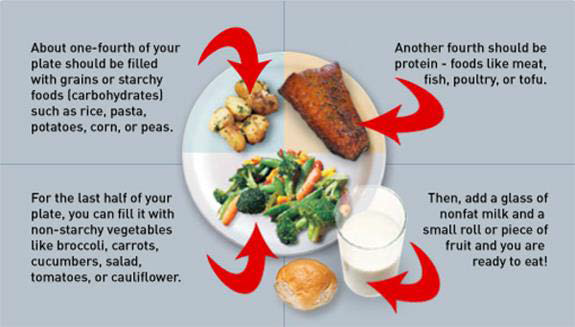- +1 (214) 929-7614
- info@goodnewsilluminer.com

An eating plan that helps promote health and manage weight includes a variety of healthy foods like fruits, vegetables, whole grains, and fat-free or low-fat milk and milk products. This will have a variety of protein foods such as seafood, lean meats and poultry, eggs, legumes (beans and peas), soy products, nuts, and seeds.
CARBOHYDRATES, PROTEINS AND FATS
The quantity of the meal matters. We need carbohydrates, protein, fat, and vegetables for our meals. We can have the protein- our meat, fish, eggs, etc.—only our palm size and deck of a card thickness. Fat comes automatically from all the foods we eat. When we buy food items from the store, read the labels. Always look for the serving size, as it is about that amount the rest of the label talks about. Look for the total carbohydrates; if more than 5 grams are listed as fiber, we could subtract it from the total as it will go out of the system. Sugar and fiber come under the total carbohydrates. 25-30 grams of fiber per day is good for us. Also, look for the total fats. Remember that mono and polyunsaturated fats are good for us, saturated fat is bad, and trans-fat is worse. Also, if we have high blood pressure, watch for sodium. In 24 hours, our maximum sodium is <2000mg. For example, a soup can have almost 500-700 grams of sodium. So, if we have soup, we must subtract it from the 2000; that is all we can have for the rest of the day. Remember, wherever salt goes, water goes. If we watch our sodium, we could even lose the water weight we might have had all this time. Ask for the carb content of the food at the restaurants or any info on the food.
SMART SNACKING
When we choose healthy snacks at the right time, it is called smart snacking. Do not consume quick sugar snacks even if the carb amount is the same as other healthy snacks. Some examples are fresh vegetable slices with salsa, lean turkey on whole grain crackers, and celery sticks filled with peanut butter.
For example, ½ cup of ice cream has 15-20gms of carbohydrates, and a packet of peanut butter crackers
has almost the same carbs. Do not think we can substitute the cracker with the ice cream because the ice cream has quick sugar, and the crackers have complex sugar. We need quick sugar only when we
know that our sugar is dropping and that also 15gms, which is ½ cup, not a full cup. We drink the rest ½ cup only if the sugar does not return more than 70 or 80 in 15 minutes when We recheck it. A healthy snack always has 1 oz protein with 15-20 grams of carbohydrates, like peanut butter crackers.
LOW CARB DIET IS NOT GOOD WHEN YOU HAVE DIABETES.
We commonly misunderstand that people with diabetes must be on low-carb diets, which is wrong.
They need energy like anybody else, and the calories or energy comes primarily from carbs. We should know how much carbohydrates we can eat at each meal. Our carbohydrate requirement is not per the weight but per the height. The extra carbs go to our hips and belly areas. It is advised to consume 45gms – 60gms carbs per meal for a medium to tall man and 30gms-45gms per meal for a medium to tall woman.
SWEETENERS
The moderate use of non-nutritive sweeteners is acceptable when we use Splenda, Truvia, and Stevia
(the most popular ones) as long as you do not use several packets for one drink. The complications from the cumulative use of these would be another 50 years from now. Still, if we use regular sugar, we may die or develop complications from uncontrolled blood sugars within months to a few years.
VITAMIN D
Vitamin D is active in regulating pancreatic beta cells, which make insulin. Other research has shown
that vitamin D and calcium supplements slow the progression of type 2 diabetes. Vitamin D is also
essential for bone health.
PLATE METHOD
We can also use this method if we need help remembering the 45-60gm carb meals. ½ of our plate is vegetables, and the other half should be our rice, potatoes, corn, etc., on one side, and proteins like
meat, fish, or poultry on the other.
“So whether you eat or drink or whatever you do, do it all for the glory of God.” (1 Corinthians 10:31). When we bring God into our healthy eating, it changes everything. Striving to honor Him in our food and drink choices will bring not only a heart change but it will also change our choices.

Priya Mathew is a Family Nurse Practitioner and working in the Department of Endocrinology at a U.S. Government Hospital in Dallas. She has written Christian devotional songs in Malayalam. She is married to Wesly Mathew and resides in Dallas with their two children.
Jesus calls us to pray with humility, persistence, and dependence on the Holy Spirit. Like...
Prayer should be a regular means of communicating with God during both the pleasant and...
Prayer contains a mystical aspect, so it is one of the best opportunities to experience...
